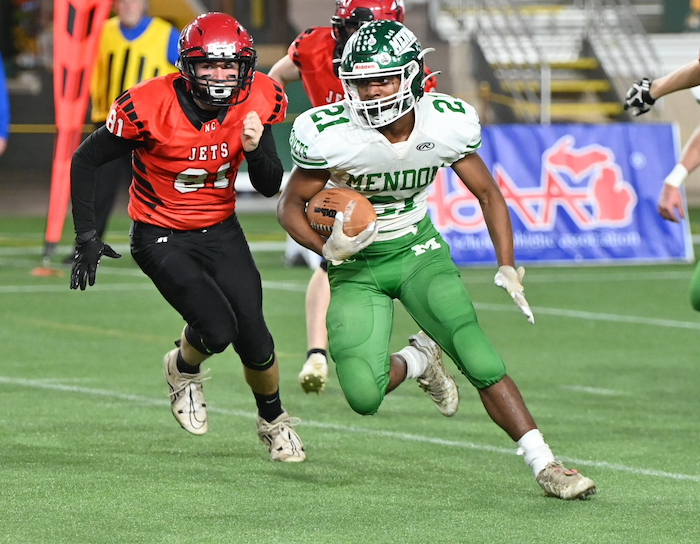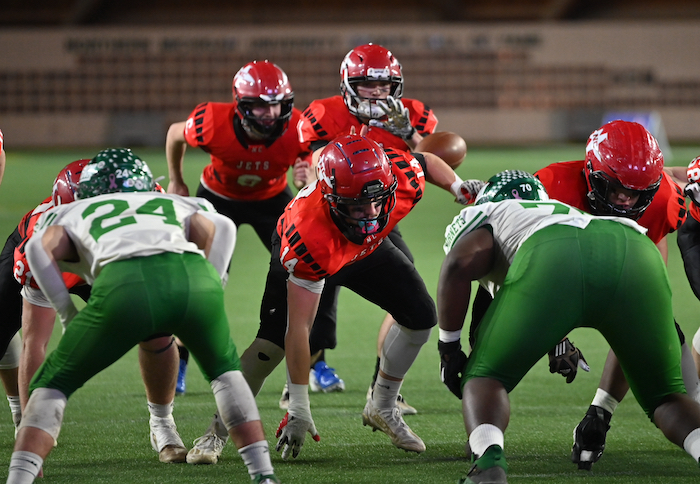
Inside Selection Sunday: Mapnalysis '13
October 28, 2013
By Geoff Kimmerly
Second Half editor
At the end of the day – Sunday, in this case – the 2013 MHSAA football playoff field was determined based on a set of numbers we began working with long before the first kickoff of this season.
So to kick off our discussion of how some of the 2013 playoff-selection decisions were made, here are a few numbers that might boggle the mind – or at least surprise:
- A total of 3,111 high school results were used in determining this season’s field – 2,978 for 11-player and 133 for 8-player games.
- We inputted and then followed the schedules for 623 MHSAA teams.
- We also inputted and followed weekly the schedules for 50 teams from surrounding states and Ontario that played at least one game against one of our MHSAA schools.
- We worked through complicated maneuverings made necessary by seven teams playing a mix of 11 and 8-player games, plus two more teams that played a mix of varsity and junior varsity opponents.
- And by Sunday morning we ended up with a few more numeric rarities: only 225 automatic qualifiers, the fewest since the current playoff system was introduced in 1999, and also an uneven number of at-large bids from our four classes because only six Class D teams reached the number of victories needed to be considered. (This was balanced by taking more at-large qualifiers from Classes A, B and C.)
And that was just the start of one of our most exciting days of the school year.
Following are more details. First, I explain some of the history of the MHSAA playoffs – I’ve lifted this in part from our 2012 report, so skip ahead if you’ve already got that down. Next, I touch on five themes that emerged as we built the brackets for this season’s tournament.
The process
Our past: The MHSAA playoff structure – with 256 teams in eight divisions, and six wins equaling an automatic berth (or five wins for teams playing eight or fewer games) – debuted in 1999, as mentioned above. An 8-player tournament was added in 2011, resulting in nine champions total when November is done.
That’s a long way from our start. The first playoffs were conducted in 1975 with four champions. Four more football classes were added in 1990 for a total of eight champions each fall. Through 1998, only 128 teams made the postseason, based on their playoff point averages within regions (four for each class) that were drawn before the beginning of the season. The drawing of Districts and Regions after the end of the regular season did not begin until the most recent playoff expansion.
In early years of the current process (or until the middle of the last decade), lines were drawn by hand. Dots representing qualifying schools were pasted on maps, one map for each division, and those maps were then covered by plastic sheets. Districts and Regionals literally were drawn with dry-erase markers.
Our present: After a late Saturday night tracking scores, we file in as the sun rises Sunday morning for a final round of gathering results we may still need (which can include making a few early a.m. calls to athletic directors). Then comes re-checking and triple-checking of enrollments, what schools played in co-ops, some records and more before the numbers are crunched and the fields are set.
Those 256 11-player teams are then split into eight equal divisions based on enrollment, and their locations are marked on digital maps that are projected on wall-size screens and then discussed by nearly half of the MHSAA staff plus a representative from the Michigan High School Football Coaches Association. Only the locations themselves are marked (by yellow dots) – not records, playoff point averages or names of the schools or towns. In fact, mentions of those are strictly prohibited. Records and playoff points are not part of the criteria. Matchups, rivalries, previous playoff pairings, etc. also DO NOT come into play. The same process is followed for organizing the 8-player bracket.
Observations and answers: 2013
This doesn’t happen overnight: Preparation for selecting the MHSAA playoff field begins long before the first kickoff of fall, much less the first practice. We load schedules for all 600-plus varsity teams during the summer, and many schedules remain fluid right up until the first Friday of the season – and this fall, a few weren’t settled until Week 2 or 3.
This summer as in some past we also worked through schools closing (Inkster, Saginaw Buena Vista, Detroit Northwestern, Flint Northern), and others deciding in mid-July and early August they would not field teams because of a lack of players.
Sometimes we have to take odd paths to find scores for these games. The last 11-player score to be added to our data this regular season came in as a result of tweeting the sports anchor of a Wheeling, W.Va., television station. Our last 8-player score came in via email from a Wisconsin athletic director at 10:30 Saturday night. Thankfully, we get plenty of assistance from some of our friends in the field, who keep an eye on the data and alert us when something appears missing or incorrect.
Win and advance: This season’s list of 5-4 teams includes a number of heavy hitters that did not receive at-large bids – East Grand Rapids, Utica Eisenhower, Orchard Lake St. Mary’s and Flint Powers Catholic to name a few. All were solid teams and played strong competition. All missing the playoffs likely raised some eyebrows.
But we have to take a look at this from a statewide view. There admittedly can be some argument about what schools qualified for the 226-256 spots in the field – but the important part is that 225 qualified because they all met the minimum win requirement. A playoff is simply that – it decides a champion based on teams winning. For some it’s harder to pile wins, of course, because they play in tough leagues. But the winners of those leagues are in the field – and surely will credit that tough road with getting them prepared to now play the state’s best.
Geography rules: This long has been rule number one for drawing MHSAA brackets in any sport, and is a repeat as well for those who have read this report the last two Octobers. Travel distance and ease DO come into play. Jumping on a major highway clearly is easier than driving across county-wide back roads, and that’s taken into consideration.
Also, remember there’s only one Mackinac Bridge and hence only one way to cross between peninsulas – and boats are not considered a possible form of transportation. When opponents from both peninsulas will be in the same District, distance to the bridge is far more important than as the crow flies.
The best example of this comes this season in Division 5. Grayling clearly is east of both Kingsley and Kalkaska – but also sits on I-75, while those two do not. So while those more western teams are geographically closer to Houghton, Menominee and Kingsford from the Upper Peninsula, we instead paired the three U.P. teams with Grayling because being on a main highway made for a shorter trip. The trip to Grayling for any of those U.P. teams would be 36 miles shorter to Grayling than Kingsley and 13 miles shorter to Grayling than Kalkaska.
Sometimes it’s where the points aren’t: Sure, it would be best-case scenario to have perfect sets of eight dots split into four quadrants from Calumet to Bedford. But generally that doesn’t occur. “Dots determine the map” is a common phrase heard here during this selection process, but that works the other way as well. If there are no qualifiers in a division from a specific area of the state – see Division 1, with none south of Holland or west of the greater Lansing area – there’s no choice but to create the unusual Regional Final possibility of Traverse City West vs. Brighton. Brighton is simply closer to the west side of the state than our other options.
Border to border vs. coast to coast: Should Regions be grouped north to south or east to west? There isn't a right or wrong answer – it just depends on that set of dots.
Whenever we have Upper Peninsula teams in a division, they’ll be grouped with those from the northernmost points of the Lower Peninsula for a District. The next northernmost schools will be grouped into a District, and together those eight will form a Region.
But the tough decision comes with the other six Districts. Look at this season’s Division 5 map: Six Districts are grouped south of U.S. 10 with three near or west of U.S. 127 and three east of that highway, which runs through the center of the Lower Peninsula. We grouped the two southwestern Districts into a Region and the two southeastern Districts into a Region – leaving a final Region that stretches from Muskegon on Lake Michigan to Almont, about 35 miles west of Lake Huron.
That’s a haul. But it’s also the best of our possible compromises. We could’ve instead paired regions that would’ve stretched from Hopkins to Monroe – only 19 fewer miles in distance than Muskegon Oakridge to Almont, but a scenario that could’ve created travel increases for a number of additional teams. Another option included a possible trip from Detroit University Prep to Freeland, which also would take more than two hours.
Bottom line – it’s been written here before – we pour all we have into this process, asking questions often more than once until we come up with a consensus. We do appreciate the arguments that arise once brackets are released to the public: The discussions are proof of how much players, coaches and fans care – and often show us new ways we can look at a system that’s now 15 years old.
But we must remember that the good news is the tournament is still set up to reward nine champions over the next five weeks, and five schools – Auburn Hills Oakland Christian, Coldwater, Detroit Allen, Eaton Rapids and Muskegon Mona Shores – will be competing for those titles for the first time.
It’s not so much how the tournament starts as how it ends. And we’re preparing for nine more memorable conclusions.
PHOTO: Each collection of grouped dots is a District on this season's Division 3 playoff map.

North Central Extends Dominance with 37th-Straight Win, 3rd-Straight Title
By
Jason Juno
Special for MHSAA.com
November 19, 2022
MARQUETTE – What a run it’s been for North Central.
The Jets haven’t lost a game over the last three years and very few, if any of those games, have been close. They’ve won them all by multiple touchdowns and just three games have finished with a margin under 30 points. Most have been won by a lot more.
Their opponent in Saturday’s Division 2 championship game, Mendon, brought a strong tradition of its own, with 12 previous Finals appearances.
But this is North Central’s era, and that’s no secret. So imagine what it must do to a team’s psyche when that juggernaut returns the opening kickoff and adds another touchdown before a full minute runs off the clock.
The Jets turned that 14-0 lead into a 66-26 win for their third consecutive – and fifth total – 8-player championship Saturday at the Superior Dome. They also won a state-record 37th straight game.
“It’s gotta be part of the mystique and part of what these kids built,” North Central coach Leo Gorzinski said. “You want to have a two-touchdown lead in their head before you get off that bus. When you come out there and do that, set that tone, of course it’s going to get in their mind.”
And North Central did it with standout quarterback, and reigning Associated Press Player of the Year Luke Gorzinski, playing through what the Jets suspect is an ACL injury.
It was Elijah Gorzinski who returned the opening kickoff 85 yards to put North Central on the board just 11 seconds into the contest. Mendon muffed the ensuing kickoff and North Central’s kicker, Adrian Mercier, recovered. Two plays later, Lane Gorzinski caught a 14-yard Luke Gorzinski pass for a touchdown and a 14-0 Jets lead 50 seconds into the game.
And North Central didn’t let up.
 The Jets scored two more touchdowns in the first quarter, one on a 36-yard run by Dillon Raab and the other a 36-yard pass from Luke Gorzinski to Lane Gorzinski to make it 28-0.
The Jets scored two more touchdowns in the first quarter, one on a 36-yard run by Dillon Raab and the other a 36-yard pass from Luke Gorzinski to Lane Gorzinski to make it 28-0.
Luke Gorzinski threw two TD passes in the second quarter, a 30-yarder to Dylan Plunger and another 20 yards to Jordan Messenger for a 41-6 lead at the half.
That opening kick return that set the tone came after North Central waited and waited for the D-1 title game to get over. The Jets went from amped up to play to the concession stand getting brats.
“We were flat; they were ready to take a nap,” Coach Gorzinski said. “Once that (return) happened, it was game on from there.”
That made four touchdown passes in the half for Gorzinski, who is explosive getting to the edge normally, but not Saturday with his injury. Leo said he wouldn’t get it checked out before the game because he just wanted to play, but Leo fears it will be an ACL injury once diagnosed.
“Thank God they didn’t catch on for a whole half that Luke Gorzinski can’t run,” Coach Gorzinski said. “He never ran a single time, and they never adjusted or blitzed him. I’ll praise God for that. Because if they would have blitzed him, I would have pulled him. That, for me, was the single thing – we knew they had a weak pass defense.”
Gorzinski ran for one touchdown in the second half, from a yard out. He caught a 33-yard TD pass and Lane Gorzinski ran 38 yards for six.
Jacob and Lane Gorzinski picked up the slack running the ball with 132 yards and 90 yards, respectively, with both getting eight carries. Four receivers caught touchdowns – Lane Gorzinski, Plunger, Messenger and Luke Gorzinski.
“If you watch what Jacob Gorzinski did today (on the ground), that’s Luke to a T, that’s Luke’s specialty. With Jacob Gorzinski stepping up, with Lane stepping up, with Dylan Plunger stepping up, the heart that Dillon Raab showed up there tonight, all of them, Max Nason, Jordan Messenger, Andrew Weber,” Coach Gorzinski said.
 Luke Gorzinski finished the day with the single yard on the ground, and only that one carry, but he was 13 of 24 passing for 207 yards and four touchdowns.
Luke Gorzinski finished the day with the single yard on the ground, and only that one carry, but he was 13 of 24 passing for 207 yards and four touchdowns.
He didn’t want to talk about how much it hurt.
“It’s Luke, man, he can play through anything,” Jacob Gorzinski said. “He’s a tough kid.”
Any way you slice it, Luke helped boost his team to a third-straight title.
“You come into this game knowing we could probably get the edge on these guys and we had good running out of our trip set, but with a bum wheel, we were limited,” he said. “We came out throwing a little more and put faith in our pass catchers, and they got it done.”
They made so many big plays, the kick return, long runs by the other guys, those big pass plays. It’s hard for an opponent to keep up.
“We did a lot of good things; we just gave up too many big plays. That’s really been our Achilles in our losses is giving up those big plays. But I give them a lot of the credit – they made the plays, they were making plays, ” Mendon coach Robert Kretschman said. “(Gorzinski) can sling the ball, he just put the ball on the money. They’re physical on the edge. That was probably one of the best perimeter blocking teams I’ve seen in a long time, 11-man, 8-man, they get after it. … Their physicality on the edge is something I don’t think we were quite prepared for.”
Mendon had an explosive player of its own in junior back Jack McCaw. He ran for three of the Hornets’ touchdowns, a 30-yarder in the second quarter to get on the board, a 58-yard rush to start the second half and a 70-yard score a few minutes later. Evan Lukeman scored Mendon’s final TD.
“We have Jack coming back. We’re excited about that,” Kretschman said.
North Central wants to keep its run going next year, but it won’t be easy after losing such a decorated group of seniors headlined by Luke Gorzinski.
Now they can savor all that they’ve done the last three years.
“We came out here to do it again; that was the goal for this season,” Jacob Gorzinski said.
And nobody was able to stop them.
PHOTOS (Top) Powers North Central’s Lane Gorzinski (6) and Dylan Plunger (10) celebrate an early touchdown Saturday at the Superior Dome. (Middle) Mendon’s Jack McCaw (21) bursts into an opening. (Below) The Jets line up on offense, led by quarterback Luke Gorzinski. (Photos by Cara Kamps.)

